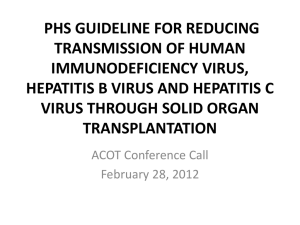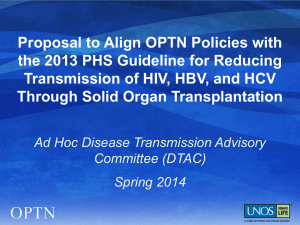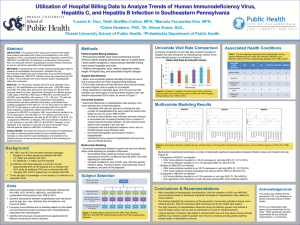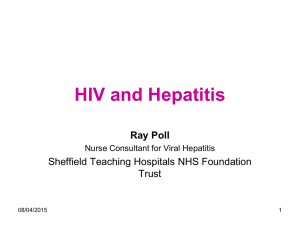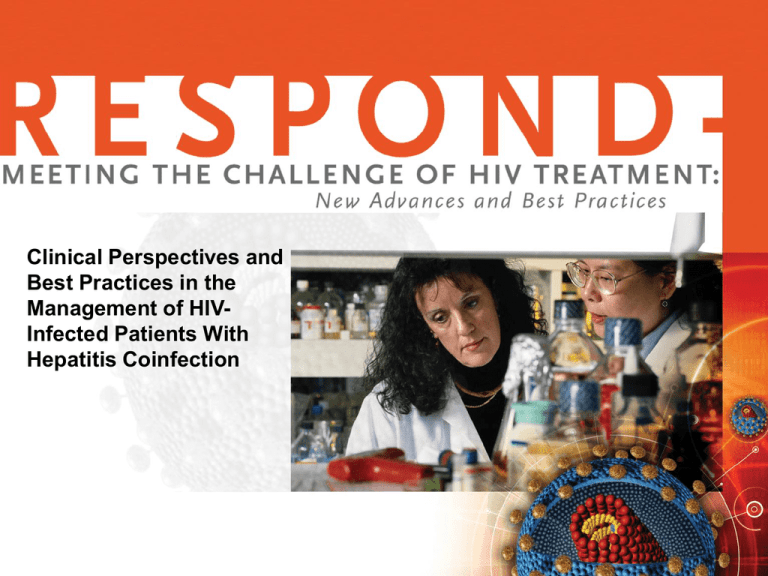
Clinical Perspectives and
Best Practices in the
Management of HIVInfected Patients With
Hepatitis Coinfection
Educational Objectives
• Describe clinical considerations that require
assessment in HIV-infected individuals with
hepatitis coinfection
• Assess the impact of HIV/hepatitis coinfection on
hepatic function and on treatment-related
adverse events
• Describe evidence-based recommendations for
the management of HIV-infected individuals who
have coinfection with hepatitis B or C
2
HIV-HCV Coinfection
3
Case 1
• 60-year-old man with long-standing HIV disease
– ART with undetectable HIV RNA ~ 10 years
• Laboratory testing was performed following a
routine office visit
–
–
–
–
ALT = 1390 U/L (was 26 U/L 3 months ago)
HCV EIA + (was negative ~ 5 years ago)
HCV RNA = 1.3 million IU/mL
HCV genotype 1A
ART = antiretroviral therapy; ALT = alanine aminotransferase; EIA = enzyme immunoassay.
4
Question
In which of the following scenarios is screening with
HCV RNA indicated?
A. Patient with normal ALT and negative HCV EIA
B. Patient with new elevation in ALT to 3 x ULN and
negative HCV EIA
C. Patient with CD4 cell count ~ 25/mm3, elevated
ALT, and negative HCV EIA
D. Patient with newly diagnosed HIV and no prior
HCV testing
E. B and C
5
HCV Coinfection Is Detected in
About One-Third of HIV-Infected
Patients
Prevalence Is Highest Among IDUs
Prevalence (%)
100
85
80
N = 1955
60
45
40
14
20
10
0
IDU
Heterosexual
Male
Entire
Contact Homosexual Cohort
Contact
IDU = injection drug user.
Alter MJ. J Hepatol. 2006;44:S6-S9.
Sulkowski MS et al. Ann Intern Med. 2003;138:197-207. Permission requested.
6
HCV Is a Sexually Transmitted
Disease Among HIV-Infected MSM
• HIV-positive MSM
diagnosed with recent
HCV (N = 226) between
2000 and 2006
• NS5B sequences were
obtained
– Phylogenetic analysis
revealed 156 (78%)
sequences that formed
11 clusters
MSM = men who have sex with men.
van de Laar T et al. Gastroenterology. 2009;136:1609-1617. Reprinted with permission. ©
2009.
7
Acute Hepatitis C in HIV-Infected
Patients Should Be Routinely
Treated
• 53 HIV-infected persons with acute HCV
infection
– 28 genotype 4; 14 genotype 1; 7 genotype 3
• Better outcomes were achieved with early
treatment with peg-IFN + RBV
– Spontaneous clearance occurred in ~ 16.5%
– Treatment-induced clearance (sustained virologic
response) occurred in ~ 82.1% (32/39)
peg-IFN = peginterferon; RBV = ribavirin.
Piroth L et al. Hepatology. 2010;52:1915-1921.
8
HCV in HIV-Infected Patients
• Universal screening (independent of risk
behaviors)
– IDU and blood exposure > sexual transmission
– Screen with HCV EIA; consider HCV RNA
screening in unique situations (eg, acute disease)
– If EIA negative, re-screen annually with EIA
• Repeat testing with high-risk exposure and/or
increase in serum ALT
9
Case 2
• 58-year-old African-American woman with wellcontrolled HIV disease (EFV/TDF/FTC)
• HCV acquired via IDU ~ 41 years prior (inactive
for many years)
– ALT level ranges from 45 to 75 U/L
– No symptoms
10
Question
Which of the following assessments should be
routinely performed on all HIV-infected persons
who are HCV EIA positive?
A. Hepatitis A antibody total
B. HCV RIBA
C. HCV RNA, quantitative assay
D. GGT
E. A and C
RIBA = recombinant immunoblot assay.
11
Evaluation of HCV in Persons With
HIV Infection
• Confirm chronic infection with HCV RNA testing
(quantitative assay)
– No role for qualitative RNA assay or RIBA
• HCV genotype
• Assess liver function: platelet count, total
bilirubin, INR, creatinine
• Fibrosis staging to assess “need” for therapy
– Liver histology
– Serum marker
– Transient elastography
INR = international normalized ratio.
12
Effect of HIV on HCV Natural
History
HCV Infection
Chronic
HIV/HCV Coinfected
Less Spontaneous
Clearance
More
Chronic
More
Cirrhosis
Cirrhosis
More ESLD,
HCC
ESLD, HCC
ESLD = end-stage liver disease; HCC = hepatocellular carcinoma.
13
Cirrhosis (%)
Impact of HIV on Liver Disease
Progression With Chronic HCV
0
5
10
15
20
25
30
Years
Thein H-H et al. AIDS. 2008;22:1979-1991.
Thein H-H et al. Hepatology. 2008;48:418-431.
14
Fibrosis by Metavir Scoring System
F1
F3
Portal tract fibrosis
F2
Numerous septa
F4
Few septa
Cirrhosis
15
AST-to-Platelet Ratio Index (APRI)
Is Readily Available at No
Additional Cost
– 86 studies, 22 included
– N = 4266 patients
– Significant fibrosis = 47%
– 0.5 threshold:
81% sensitive and 50%
specific for exclusion of
significant disease
AST = aspartate aminotransferase.
100
90
Sensitivity (%)
• Wai et al (2003) APRI =
AST level (/ULN) X 100
Platelet count (109/L)
• Shaheen et al (2007)
Meta-analysis
80
70
60
50
40
30
20
10
Area under curve = 0.76
(95% CI, 0.74-0.79)
0
100 90 80 70 60 50 40 30 20 10 0
Specificity (%)
Wai CT et al. Hepatology. 2003;38:518-526.
Shaheen AA et al. Hepatology. 2007:46:912-921. Permission requested.
16
ESLD/HCC/Liver Death-Free Survival
by Metavir Stage in Patients
Coinfected With HIV/HCV
N = 638 adults
Metavir = 0
Metavir = 1
Sulkowski MS et al. CROI 2010. Abstract 166.
Metavir = 2
Metavir = 3
Metavir = 4
17
SVR Reduces Liver Mortality in
HIV/HCV Coinfection
• Cohort study, 11 centers in Spain
• 2000-2005, 711 patients start
IFN/RBV
– 31% had SVR
– Mean follow-up was 20.8 months
• Incidence rate (1000 personyears)
SVR
No SVR
P Value
Death
Liver
death
0.46
3.12
0.003
0.23
1.65
ESLD
0.23
4.33
0.028
<0.001
SVR = sustained virologic response.
SVR
100%
NO SVR
80%
60%
40%
20%
0%
P <0.001 by log-rank test
0 6 12 18 24 30 36 42 48
Follow-up (months)
Kaplan-Meier estimates of liver-related
events by SVR (N = 711)
Berenguer J et al. Hepatology. 2009;50:407-413. Permission requested.
18
Case 3
• 58-year-old African-American woman with wellcontrolled HIV disease (EFV/TDF/FTC)
– HCV genotype 1A
– HCV RNA level = 2.3 million IU/mL
– Metavir fibrosis stage = F3
• Treatment initiated with FDA-approved regimen
for HCV in HIV-infected patients
– Peg-IFN alfa + RBV 800 mg/day
19
Question
What is the likelihood of this patient achieving a
sustained virologic response with peg-IFN + RBV ?
A. 0% to 10%
B. 10% to 20%
C. 20% to 30%
D. 30% to 40%
E. >40%
20
PARADIGM: Weight-Based RBV in
HIV/HCV Coinfection
Peg-IFN alfa-2a (40 KD)
180 µg/week (N = 135)
Follow-up
Plus RBV 800 mg/day
Double-blinded,
Phase IV,
1:2
randomization
(N = 410)
Peg-IFN alfa-2a (40 KD)
180 µg/week (N = 275)
Follow-up
Plus RBV 1000/1200 mg/day
0
12
24
48
72
Study Weeks
Rodriguez-Torres M et al. AASLD 2009. Abstract 1561.
21
PARADIGM:
Baseline Characteristics
RBV Dose (mg/day)
800 mg
1000/1200 mg
79%
81%
Mean age, yr
45
46
Mean weight, kg
77
78
Black
34%
33%
ALT quotient ≤1.5
56%
52%
Advanced fibrosis
12%
11%
Mean log10 HCV RNA
6.4
6.4
<200 CD4 cells/µL
5%
7%
On ART
89%
88%
Male
Rodriguez-Torres M et al. AASLD 2009. Abstract 1561.
22
PARADIGM: SVR by Race/Ethnicity
50
SVR (%)
40
30
26
22
20
24
20
19
13
9
10
135 275
86
176
33
5
62
40
77
0
All patients Caucasian
Ribavirin 800 mg/day
Rodriguez-Torres M et al. AASLD 2009. Abstract 1561.
Hispanic
Black
Ribavirin 1000/1200 mg/day
23
PARADIGM:
Most Frequently Reported AEs
RBV
800 mg/day (%)
RBV 1000/1200
mg/day (%)
Fatigue
47
47
Headache
36
34
Anemia
24
32
Insomnia
26
28
Nausea
26
25
Pyrexia
27
23
Depression
22
25
Decreased appetite
25
22
Neutropenia
24
23
Myalgia
29
19
Diarrhea
23
22
Rodriguez-Torres M et al. AASLD 2009. Abstract 1561.
24
Genetic Variation in IL288 Predicts
Hepatitis C Treatment-Induced Viral
Clearance
2
1
3
4
5
6
8
7
10
9
11
12
13
15
14
16
17
18 20 22
19 21 X
Y
M
-log10 (P)
30.0
rs12979860
P=1.37 × 10 -28
15.0
0.0
Chromosome 19 ideogram
0M
10 M
39,623 K
39,666 K
20 M
30
M
39,708 K
40 M
39,750 K
50 M
60 M
39,793 K
39,835K
-log10 (P)
30.0
15.0
0.0
NCCRP1
PAK4
39,711 K
39,721 K
39,732 K
SYCN
39,743 K
IL28B
39,753 K
AC011445.6
IL28A
IL29
LRFN1
GMFG
39,764K
-log10 (P)
30.0
15.0
0.0
IL28B
AC011445.6
Ge D et al. Nature. 2009;461:399-401. Permission requested.
IL28A
25
HIV/HCV Coinfection: IL28B
Genotype Associated With
Increased SVR
CC
SVR Rate (%)
100
P<0.0001
75
80
P = 0.001
Non-CC
P = 0.68
86
81
65
P = 0.09
67
60
40
38
30
25
20
0
Overall
n = 164
Rallon NI et al. AIDS. 2010;24:F23-F29.
HCV-1
n = 95
HCV-3
n = 51
HCV-4
n = 18
26
Case 4
• 48-year-old man with HIV/HCV coinfection
– HIV is well controlled on DRV/r + TDF/FTC (first
regimen)
– HCV genotype 1A
– HCV RNA ~ 3.4 million IU/mL
– Liver biopsy: Stage 2 fibrosis
• The patient asked if he is a candidate for the
new HCV protease inhibitors
27
Question
Which of the following statements regarding firstgeneration HCV NS3/4A protease inhibitors is
NOT correct?
A. Drug-drug interactions with antiretroviral
agents may occur
B. HCV variants resistant to these agents may
be selected during therapy
C. Ribavirin need not be administered in
combination with these potent agents
D. Anemia is a potential side effect
28
Protease Inhibitor + Peg-IFN + RBV
• Boceprevir 800 mg po tid + peg-IFN + RBV
– Start with peg-IFN/RBV x 4 weeks “lead-in”
– Add BOC for 24 or 44 weeks, depending on
HCV RNA response at treatment week 8
– AEs due to BOC: anemia, dysguesia
– Resistant variants selected with treatment failure
(same variants as telaprevir)
– Drug-drug interactions likely
– No data in HIV/HCV
BOC = boceprevir.
29
SPRINT-2: SVR and Relapse Rates
(ITT)
P<0.0001
P = 0.004
P<0.0001
Non-Black Patients
P = 0.044
SVR
Black Patients
Relapse Rate
RGT = response-guided therapy.
Poordad F et al. AASLD 2010. Abstract LB-4.
30
Boceprevir: Metabolism and DrugDrug Interactions
• Substrate of aldoketoreductase primary pathway
• Substrate of CYP3A4/5
– Coadministration of EFV (CYP3A4/5 inducer)
decreased BOC mean exposure 19% to 44% and
increased efavirenz mean exposure 11% to 20%
– No RTV boost
• Strong CYP3A4 inhibitor without evidence of
induction
‒ BOC Midazolam AUC markedly increased
• Substrate for the efflux inhibitor P-glycoprotein (P-gp)
• No drug-drug interactions with tenofovir
AUC = area under the curve.
Kasserra C et al. CROI 2011. Abstract 118.
31
Protease Inhibitor + Peg-IFN + RBV
• Telaprevir 750 mg po tid + peg-IFN + RBV
– Start with TVR + peg-IFN/RBV stop TVR
after 12 weeks
– Total duration of therapy of 24 or 48 weeks depending
on HCV RNA response at treatment week 4
– AEs due to TVR: anemia, rash
– Resistant variants selected with treatment failure
(same variants as boceprevir)
– Drug-drug interactions likely
– Limited data in HIV/HCV
32
ADVANCE: Achievement of SVR
100
SVR (%)
90
80
T12PR and T8PR vs PR: P<0.0001
75%
69%
70
60
44%
50
40
30
20
10
0
T12PR
T8PR
Jacobson IM et al. AASLD 2010. Abstract 211.
PR
33
TVR Concentration (ng/mL)
Effect of HIV Protease Inhibitors on
Telaprevir
LPV
n = 14
ATV
n = 17
DRV
n = 16
fAPV
n = 20
TVR
alone
TVR +
ARV
n = 12
AUC ↓ 54%
n = 14
AUC ↓ 20%
n = 11
AUC ↓ 35%
n = 18
AUC ↓ 32%
Time (hours)
TVR = telaprevir.
van Heeswijk R et al. CROI 2011. Abstract 119.
34
n = 12
AUC ↔
PI Alone
PI + TVR
n = 16
AUC↓ 40%
n = 11
ATV Concentration
(ng/mL)
PI Alone
PI + TVR
n = 19
APV Concentration
(ng/mL)
DRV Concentration
(ng/mL)
LPV Concentration
(ng/mL)
Effect of Telaprevir on HIV
Protease Inhibitors
PI Alone
PI + TVR
n=7
AUC ↑ 17% n = 11
PI Alone
PI + TVR
n = 20
AUC↓ 47%
n = 18
APV = amprenavir.
van Heeswijk R et al. CROI 2011. Abstract 119.
35
Telaprevir + Peg-IFN/RBV in
HIV/HCV Coinfected Patients
• Phase 2a TVR study
‒ 60 patients; 41/59 patients reached week 12
‒ Part A: no ART CD4 lymphocyte >500/mm3,
n = 13
‒ Part B: stable TDF/FTC (3TC) EFV, n = 24 or
ATV/r, n = 22
• Higher TVR (1125 mg q8 hours) for EFV
• Stopping rules: HCV RNA >1000 IU/mL
• CD4 cell count median >500/mm3
Sulkowski M et al. CROI 2011. Abstract 146LB.
36
Week 4: Undetectable HCV RNA
Total
Total
n/N =
Telaprevir + PR
No ART
EFV/TDF/FTC
Sulkowski M et al. CROI 2011. Abstract 146LB.
PR
ATV/r + TDF + FTC/3TC
PR
37
Week 12: Undetectable HCV RNA
Total
Total
n/N =
Telaprevir + PR
No ART
EFV/TDF/FTC
Sulkowski M et al. CROI 2011. Abstract 146LB.
PR
ATV/r + TDF + FTC/3TC
PR
38
No Effect of Telaprevir on HIV
Suppression Was Observed
No ART (T/PR)
No ART (PR)
EFV/TDF/FTC (T/PR)
EFV/TDF/FTC (PR)
ATV/r + TDF + FTC/3TC (T/PR)
ATV/r + TDF + FTC/3TC (PR)
Mean Log10 HIV RNA
Change
1
4
8
12 Weeks
0
-1
-2
Sulkowski M et al. CROI 2011. Abstract 146LB.
39
Serious Adverse Events and
Treatment Discontinuation in
HIV/HCV Coinfected Patients
Part A
Part B
ATV/r + TDF +
No ART
EFV/TDF/FTC
FTC/3TC
T/PR
PR
T/PR
PR
T/PR
PR
N = 7 N = 6 N = 16 N = 8 N = 14 N = 8
Any AE, n (%)
7 (100)
5 (83)
15 (94)
7 (88)
14 (100)
8 (100)
Serious AE, n (%)
1 (14)
0
0
0
2 (14)
0
Discontinuation of all
study drugs due to AE,
n (%)
0
0
0
0
2 (14)
0
Due to jaundice
0
0
0
0
1 (7)
0
Due to anemia
0
0
0
0
1 (7)
0
Due to rash
0
0
0
0
0
0
Sulkowski M et al. CROI 2011. Abstract 146LB.
40
Treatment of HCV in HIV-Infected
Persons ~ 2011
• Genotype 2, 3, 4: peg-IFN/RBV x 48 weeks
• Genotype 1 + no ART or ART with EFV or ATV/r
or RAL: telaprevir (12 weeks) + peg-IFN/RBV x
48 weeks
• Genotype 1 + incompatible ART and unable to
switch: peg-IFN/RBV x 48 weeks
• Recommendations for boceprevir pending drugdrug interaction studies and Phase 2 data
41
HIV-HBV Coinfection
42
Case 5
• 44-year-old man with long-standing HIV disease
with CD4 nadir ~ 10/mm3; now 345/mm3
– History of resistance to 3TC/AZT
– HIV is currently suppressed on ATV/r + TDF +
FTC
– HBsAg+ since HIV diagnosis
– HBV DNA currently <22 IU/mL
– Platelet count slightly low ~ 132,000
43
Question
Which of the following statements regarding screening
for HCC in patients with active HIV-HBV coinfection is
correct?
A. Liver imaging with ultrasound or other modality
should be performed ~ every 6 to 12 months
B. Only patients with cirrhosis should be screened
C. Serum AFP is sensitive and specific for the
diagnosis of HCC
D. Screening is not indicated because there are no
effective treatments for HCC
AFP = alpha fetoprotein.
44
Universal Screening for all HIVInfected Persons; HBsAg and HBsAb
HBsAg Anti-HBs
-
+
Meaning
Action
-
Susceptible
Vaccinate
+
Immune, prior
infection or
vaccine
None
-
Chronic (or acute)
hepatitis B
Evaluate
45
HBV Prevalence Stable Over 11
Years in the United States
Percent Infected
12
HIV Risk Group
10
8
6
4
2
MSM
IDU
HRH
All HOPS
0
HRH = high-risk heterosexual; HOPS = HIV outpatient study.
Spradling PR et al. J Viral Hepat. 2010;17:879-886. Reprinted with permission. © 2010.
46
Liver Disease Remains the Second
Leading Cause of Death in Later HAART
Era in HIV-Infected Persons in D:A:D
• 33,308 participants from 1999-2008
– 15.3% with HCV (Ab or RNA+)
– 11.5% HBV (prior/active)
• 2482 deaths
– 29.9% AIDS-related
– 13.7% liver-related
– 11.6% CVD-related
• Liver-related deaths declined over time
– 2.67/1000 PYs (1999-2000) to 1.45/1000 PYs (2007-2008)
• Rates highest in CD4<100 cells/mm3
HAART = highly active antiretroviral treatment; PYs = person-years of follow-up.
D:A:D Study Group. AIDS. 2010;24:1537-1548.
47
Factors Associated With LiverRelated Death in D:A:D
Factor
Adjusted RR
95% CI
Age, per 5 years older
1.16
1.09-1.24
IDU (MSM reference)
5.02
3.56-7.08
HTN
2.34
1.83-2.99
Diabetes
2.37
1.68-3.35
HCV
1.67
1.21-2.31
HBV
2.37
1.74-3.22
CD4 count
per 50 cell/μL increase
0.82
0.79-0.85
HIV RNA >5 log c/mL
1.68
1.01-2.80
HTN = hypertension.
D:A:D Study Group. AIDS. 2010;24:1537-1548.
48
Management of HIV-Infected
Patients Who Are HBsAg Positive
• Counsel to avoid alcohol
• Vaccinate against HAV
• Monitor HBV DNA to determine replication prior
to any treatment and during therapy
• Test HBeAg and HBeAb
• Test HDV antibody
• Screen for hepatocellular carcinoma ~ semiannual for most patients
– Serum AFP
– Hepatic imaging, ultrasound, or other modalities
49
Case 6
• 25-year-old man with newly diagnosed HIV
– No prior antiretroviral therapy
– CD4 count = 823/mm3
– HBsAg positive; HBeAg positive;
HBV DNA = 1.3 million IU/mL
– ALT = 23 U/L
50
Question
Which of the following drugs are active against
both HBV and HIV?
A. Tenofovir
B. Lamivudine
C. Entecavir
D. Emtricitabine
E. Adefovir
F. All of the above
51
Impact of HBV Coinfection on
Selection of ART
31-year-old man;
CD4 596 cells/mm3
entecavir
108
104
106
103
104
102
102
-36 -30 -24 -18 -12 -6
0
Plasma HIV RNA
(c/mL)
105
1010
Plasma HBV DNA
(IU/mL)
• All persons with
chronic HBV should
have HBV DNA testing
prior to ART
• Lamivudine,
emtricitabine, tenofovir,
and entecavir are
active against both HIV
and HBV
101
6 12
Time Before and After Initiation
of Entecavir (months)
McMahon MA et al. N Engl J Med. 2007;356:2614-2621. Reprinted with permission. © 2007.
52
Goals of HBV Therapy
• Prevent complications of liver disease
–
–
–
–
Histologic progression to cirrhosis
Decompensated liver disease
Liver cancer
Death
• Mechanisms to achieve primary goal
– HBeAg and HBsAg seroconversion
– Long-term suppression of HBV replication
53
Recommended Therapy for Chronic
HBV Infection: AASLD, APASL, and
EASL
• Consensus among American, European, and
Asian-Pacific guidelines
• Preferred regimen
– Tenofovir* 300 mg/day
– Entecavir* 0.5 mg/day (wild-type HBV); 1 mg/day
(lamivudine-resistant HBV)
– Peg-IFN alfa
*In HIV+ persons, both tenofovir and entecavir
must be used with a fully suppressive
antiretroviral regimen.
54
DHHS Recommendations for
Treatment of HIV/HBV Coinfected
Patients
Need to Treat
Recommendation
TDF/FTC or TDF + LAM considered first-choice NRTI
Both HIV and HBV backbones + suppressive ARV regimen treat both
HIV and HBV
TDF/FTC or TDF + LAM considered first-choice NRTI
HIV but not HBV
backbones + suppressive ART regimen treat both
HIV and HBV
TDF/FTC or TDF + LAM considered first-choice NRTI
HBV but not HIV
backbones + suppressive ART regimen treat both
HIV and HBV
DHHS guidelines for the use of antiretroviral agents in HIV-1 infected adults and
adolescents. January 10, 2011. Available at http://aidsinfo.nih.gov. Accessed May 26, 2011.
55
Anti-HBV Combination Therapy Is
Associated With Greater HBV DNA
Suppression
Suppression (%)
• Suppression of HBV DNA was
greatest with TDF + FTC or LAM
100
90
80
70
60
50
40
30
20
10
0
• In ordinal logistic regression
model, monotherapy was
associated with higher HBV DNA
OR
95% CI
HBV-active therapy
TDF + FTC/LAM*
All
Subjects
<100 IU/mL
No HBV LAM
Therapy
100-1999 IU/mL
TDF TDF+
FTC/LAM
2000-19,999 IU/mL
>20,000 IU/mL
LAM = lamivudine.
Matthews GV et al. AIDS. 2009;23:1707-1715.
1
Not taking TDF, LAM, or FTC
16.8
4.1-69.0
LAM or FTC only
36.6
7.2-186.0
TDF only
8.4
1.3-54.0
Detectable HIV virus
7.4
2.4-22.3
HBeAg-positive
85.2
18.2-398.6
Association of HBV DNA level with therapy, HIV RNA, and
HBeAg positivity is shown. CI = confidence interval; OR =
odds ratio. *Reference group.
56
Discontinuation of ART Active
Against HBV is Dangerous
Non-HBV/HCV
HBV
HCV, not HBV
Cumulative Percent
Reinitiated
• Discontinuation of
agents with anti-HBV
activity may cause
serious hepatocellular
damage resulting from
reactivation of HBV
• Patients should be
advised against selfdiscontinuation and
carefully monitored
during interruptions in
HBV treatment
100
90
80
70
60
50
40
30
20
10
0
0
4
8
12
16
20
24
Months from Randomization
Non-HVB/HCV:
HVB:
HCV, not HVB:
2237
72
411
1395
38
271
933
22
188
621
12
123
1433
8
100
326
7
78
238
3
60
SMART study: Discontinuation of ART was
linked to HBV flares and the need to re-start
ART in coinfected patients
DHHS guidelines for the use of antiretroviral agents in HIV-1 infected adults and adolescents.
January 10, 2011. Available at http://aidsinfo.nih.gov. Accessed May 26, 2011.
Dore GJ et al. AIDS. 2010;24:857-865. Reprinted with permission. © 2010.
57
Case 7
• 63-year-old man with chronic HBV, HIV disease,
hypertension, and type 2 DM
– Fully suppressed HIV on regimen of
EFV/TDF/FTC
– Serum creatinine has increased; his nephrologist
recommends modifying TDF to lower dose
– HBV DNA detectable, 950 U/mL
• Management of HBV?
58
HBV DNA log10
Addition of Entecavir to Tenofovir in
HIV/HBV Infected Patients Failing to
Fully Suppress HBV Replication
10
9
8
7
6
5
4
3
2
1
0
X
X
X
X
+
+
X
+
X
X
X
X
+
X
+
X
X
X
X
X
X
X
W-24 W-12
X
X
X
X
X
X
X
W 0 W 12 W 24 W 36 W 48 W 60 W 72 W 84 W 96 W 144
Time on HBV Therapy (weeks)
Ratcliffe L et al. AIDS. 2011;25:1051-1056. Reprinted with permission. © 2011.
59
Role of Entecavir in HIV/HBV
Coinfection
• ETV should be reserved for the patient in whom
TDF is contraindicated
– Less effective for lamivudine-resistant HBV
compared to wild-type due to cross-resistance
– Use with fully-suppressive ART regimen
• Limited data in combination with TDF
– No HBV cross-resistance between TDF
and ETV
60
Summary
• Hepatitis C
– Screen all persons; repeat annually if
seronegative
– Evaluate all HCV-antibody-positive persons
– Consider HCV treatment with peg-IFN/RBV or
telaprevir + peg-IFN/RBV
• Hepatitis B
– Screen all persons; vaccinate if seronegative
– Evaluate and screen all HBsAg-positive persons
– Treat both HIV and HBV with fully suppressive
ART with TDF + FTC or TDF + 3TC
61
Glossary of Acronyms:
Antiretroviral Drugs
• Nucleoside/Nucleotide Reverse
Transcriptase Inhibitors
–
–
–
–
–
–
• Protease Inhibitors
–
–
–
–
–
–
ATV/r: ritonavir-boosted atazanavir
DRV: darunavir
fAPV: fosamprenavir
LPV/r: ritonavir-boosted lopinavir
r: ritonavir
TPV: tipranavir
ABC: abacavir
ddI: didanosine
d4T: stavudine
FTC: emtricitabine
TDF: tenofovir disoproxil fumarate
• Entry (CCR5) Inhibitor
ZDV: zidovudine (also known as
– MVC: maraviroc
AZT)
– VCV: vicriviroc
– 3TC: lamivudine
• Fusion Inhibitor
• Nonnucleoside Reverse
Transcriptase Inhibitors
– DVR: delavirdine
– EFV: efavirenz
– ETR: etravirine
– ENF: enfuvirtide
• Integrase Inhibitors
– RAL: raltegravir
62


